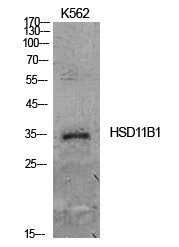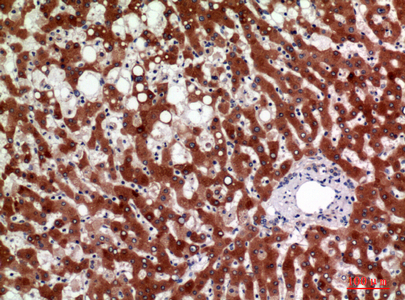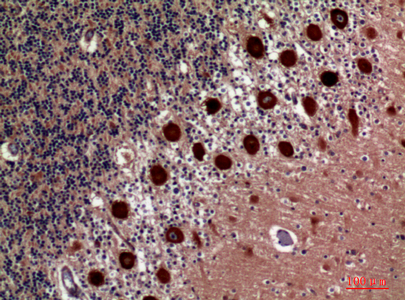11β-HSD1 Polyclonal Antibody
- Catalog No.:YT5560
- Applications:WB;IHC;IF;ELISA
- Reactivity:Human;Mouse;Rat
- Target:
- 11β-HSD1
- Fields:
- >>Steroid hormone biosynthesis;>>Metabolism of xenobiotics by cytochrome P450;>>Metabolic pathways;>>Chemical carcinogenesis - DNA adducts
- Gene Name:
- HSD11B1
- Protein Name:
- Corticosteroid 11-beta-dehydrogenase isozyme 1
- Human Gene Id:
- 3290
- Human Swiss Prot No:
- P28845
- Mouse Gene Id:
- 15483
- Mouse Swiss Prot No:
- P50172
- Rat Gene Id:
- 25116
- Rat Swiss Prot No:
- P16232
- Immunogen:
- Synthesized peptide derived from 11β-HSD1 . at AA range: internal
- Specificity:
- 11β-HSD1 Polyclonal Antibody detects endogenous levels of 11β-HSD1 protein.
- Formulation:
- Liquid in PBS containing 50% glycerol, 0.5% BSA and 0.02% sodium azide.
- Source:
- Polyclonal, Rabbit,IgG
- Dilution:
- WB 1:500 - 1:2000. IHC: 1:100-1:300. ELISA: 1:10000.. IF 1:50-200
- Purification:
- The antibody was affinity-purified from rabbit antiserum by affinity-chromatography using epitope-specific immunogen.
- Concentration:
- 1 mg/ml
- Storage Stability:
- -15°C to -25°C/1 year(Do not lower than -25°C)
- Other Name:
- HSD11B1;HSD11;HSD11L;Corticosteroid 11-beta-dehydrogenase isozyme 1;11-beta-hydroxysteroid dehydrogenase 1;11-DH;11-beta-HSD1
- Observed Band(KD):
- 35kD
- Background:
- hydroxysteroid 11-beta dehydrogenase 1(HSD11B1) Homo sapiens The protein encoded by this gene is a microsomal enzyme that catalyzes the conversion of the stress hormone cortisol to the inactive metabolite cortisone. In addition, the encoded protein can catalyze the reverse reaction, the conversion of cortisone to cortisol. Too much cortisol can lead to central obesity, and a particular variation in this gene has been associated with obesity and insulin resistance in children. Mutations in this gene and H6PD (hexose-6-phosphate dehydrogenase (glucose 1-dehydrogenase)) are the cause of cortisone reductase deficiency. Alternate splicing results in multiple transcript variants encoding the same protein.[provided by RefSeq, May 2011],
- Function:
- catalytic activity:An 11-beta-hydroxysteroid + NADP(+) = an 11-oxosteroid + NADPH.,disease:Defects in HSD11B1 are a cause of cortisone reductase deficiency (CRD) [MIM:604931]. In CRD, activation of cortisone to cortisol does not occur, resulting in adrenocorticotropin-mediated androgen excess and a phenotype resembling polycystic ovary syndrome (PCOS).,function:Catalyzes reversibly the conversion of cortisol to the inactive metabolite cortisone. Catalyzes reversibly the conversion of 7-ketocholesterol to 7-beta-hydroxycholesterol. In intact cells, the reaction runs only in one direction, from 7-ketocholesterol to 7-beta-hydroxycholesterol.,PTM:Glycosylated.,similarity:Belongs to the short-chain dehydrogenases/reductases (SDR) family.,subunit:Homodimer.,tissue specificity:Widely expressed. Highest expression in liver.,
- Subcellular Location:
- Endoplasmic reticulum membrane ; Single-pass type II membrane protein .
- Expression:
- Widely expressed, highest expression in liver, lower in testis, ovary, lung, foreskin fibroblasts, and much lower in kidney (PubMed:1885595). Expressed in liver (at protein level) (PubMed:21453287). Expressed in the basal cells of the corneal epithelium and in the ciliary nonpigmented epithelium (both at mRNA and at protein level) (PubMed:11481269).
- June 19-2018
- WESTERN IMMUNOBLOTTING PROTOCOL
- June 19-2018
- IMMUNOHISTOCHEMISTRY-PARAFFIN PROTOCOL
- June 19-2018
- IMMUNOFLUORESCENCE PROTOCOL
- September 08-2020
- FLOW-CYTOMEYRT-PROTOCOL
- May 20-2022
- Cell-Based ELISA│解您多样本WB检测之困扰
- July 13-2018
- CELL-BASED-ELISA-PROTOCOL-FOR-ACETYL-PROTEIN
- July 13-2018
- CELL-BASED-ELISA-PROTOCOL-FOR-PHOSPHO-PROTEIN
- July 13-2018
- Antibody-FAQs
- Products Images

- Western Blot analysis of K562 cells using 11β-HSD1 Polyclonal Antibody. Antibody was diluted at 1:500. Secondary antibody(catalog#:RS0002) was diluted at 1:20000

- Immunohistochemical analysis of paraffin-embedded human-liver, antibody was diluted at 1:100

- Immunohistochemical analysis of paraffin-embedded human-brain, antibody was diluted at 1:100



